What a weekend!
Not only did I go back to see David Robertson for his Intermediate Course, but my wife & I decided that she and the kids would come too, and make a mini-vacation out of it. They would do day-trips while I was blacksmithing. Four days, 1,100 kilometers of driving and a first proper family vacation later, and I am exhausted!
The course was everything I’d hoped it would be. As mentioned, this one is more technique-oriented. We did a lot of things … a fair bit of punching, slitting and drifting, made a slitting chisel, different types of joinery, and forge welding.
The first project was a bar (1/2″ square), which we drew out to a long point, punched through, and fed the tapered point back through the bar – what David called ‘threading the needle‘. It makes for quite an interesting form, and a very comfortable handle too. We broke off from this bar for a while to make our own slitting chisels. New chisels in hand, we slit another section of the bar, are drifted it out to a circle on a cone mandrel. This circle was then twisted.
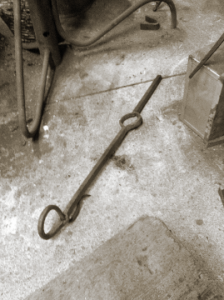
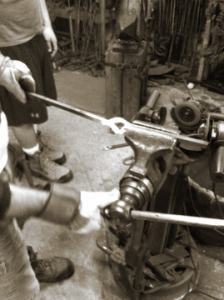
We were done with this bar at this point, but at the end of the day on Sunday (when students have time for personal projects), I forged out the other end of the bar to make a fire poker for my dad (after all, Father’s Day is fast approaching).
The slitting chisels are by far one of the most useful tools I’ve made so far:
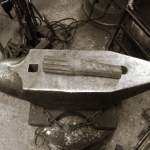
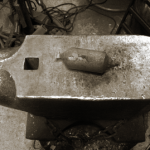
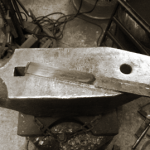
It started off as a short section of steel that’s similar to S7 (from a NASCAR axel, apparently); and was drawn out under the air hammer before a bit of grinding and a light sanding. And I’ve got to say, thank goodness for an air hammer! That’s definitely something to put on my long-term wish list.
Slitting chisels made, we continued to put them to good use for the rest of the course – and they performed marvelously – as good as any commercially made tool that I could buy.
I’m still a bit tired (sleep deprived – mainly due to the toddlers), so am having difficulty remembering what projects we did in what order. However, in no particular order:
We made two as-near-to-identical-as-possible scrolls using a scrolling jig. These two scrolls were later joined using hot-wrapping. I really liked doing the hot wrapping. I think I could happily do that all day, and will certainly find projects to do it on. Will have to add a torch kit to my wish list too…
One of my favourite projects / techniques was the mortise & tenon joint. I have to say, that it is this project that has taken away any apprehension I had for working with larger, thicker material.
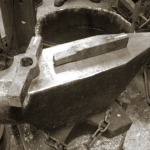
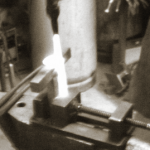
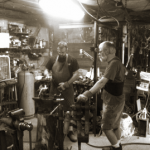
The larger bar was slit through (which was a heck of a lot of hard work), and drifted into a square hole. The other bar was forged to form the tenon. After a test-fit, it was time to upset the end of the tenon.
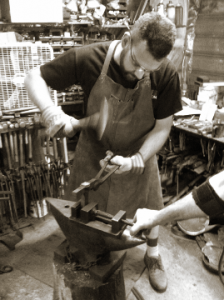
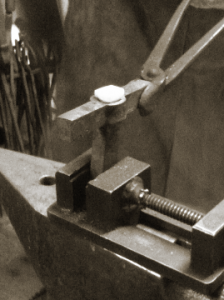
We also did a wedged joint – which I suppose is a type of a mortise & tenon, except that the tenon is a strap that’s bent over, and held tight with a wedge (hmm, looks like I didn’t happen to take a photo yet to upload). In any case, I like it a lot. To me, this joint would add a fair amount of ‘wow factor’ to a completed project.
At the end of the weekend, I finally had the opportunity to successfully do a forge weld! Now, this was very exciting to me, as I had tried on a couple of occasions on my own, with out much success. I think the problems I’d had on my own was that:
- I’d never seen a ‘welding heat’, and was probably a bit on the cold side coming out of the forge (having burnt a piece I let get too hot); and
- I was working with smaller stock (1/4″ round). Being a little apprehensive, and the stock being small and a little on the cool side to begin with, it cooled off too quickly on the anvil before I smacked it.
However, with some instruction and guidance, I was able to do it on the course with no problems. And I was thrilled! I’ll definitely need some practice, but at least now know what to look for (photographs & videos suck at accurately showing colours – you really do need to see it in person) as far a a proper temperature.
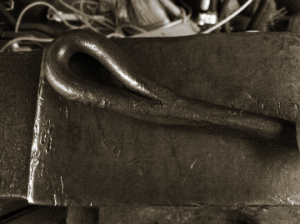
My first Forge Weld!
I rounded out the weekend with a couple of personal projects: I made a spring-style hold down for my anvil; as mentioned above, I forged the other end of the one bar into a fire poker; and I started on a ‘Wizard Hook’ for my son before running out of time … but I’ll easily finish it off at home.
All in all, it was a great course, and a wonderful weekend. I picked up some new skills, renewed my confidence, and re-charged my batteries. The biggest lesson I took away, was to always keep learning. If you’re getting bogged down, go do some learning with someone else. Borrow some ideas, pick up a few tricks, or get another perspective.
I will definitely be back to see David again in the future (I like the looks of his ‘Organics’ course), and will probably look at some of the others offering courses too. I think doing a course or two a year, with various smiths, will be a very useful thing. The experiences are so valuable, that the monetary cost of them is insignificant.
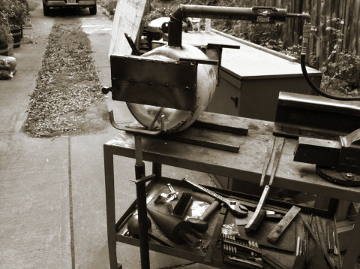
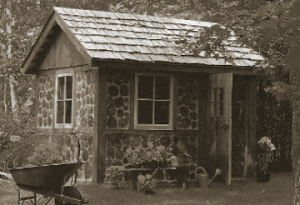











You must be logged in to post a comment.